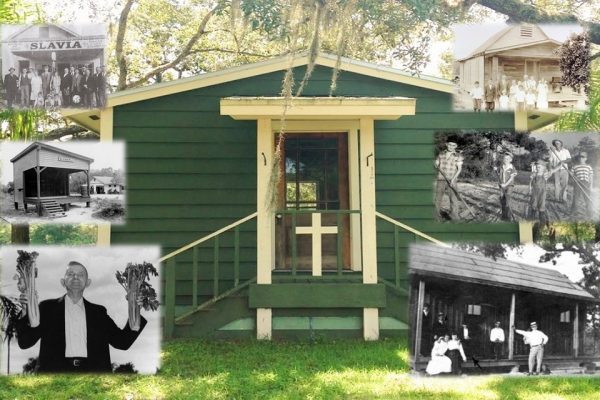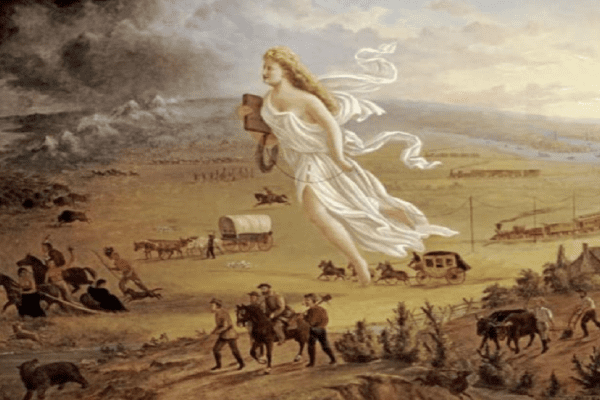Today we’re very pleased to have a guest post written by Jana Riley of Texas. You can learn more about Jana after the post….
Wearing a kroj in Texas is a tradition in my family for more than four generations beginning in the Czech Republic, specifically the Slovácko region of Moravia, and brought to Texas. I first began wearing kroj when I was not quite two years old when my grandmother dressed me in my first one for our Czech festival, WestFest. My grandmother was one of the first participants in the parade of authentic kroj from Bohemia and Moravia which showcases kroj from the regions of the Czech Republic and Slovakia each year. For over 30 years, over 40 participants wear authentic kroj or Americanized kroj which they have made themselves or purchased to represent their ancestral village of origin.
Family lore states that when I was a toddler my grandmother dressed me and went to show me off when my family was working outside, supposedly I immediately loved it and showed off my new outfit and was not scared of going in front of crowds. The same kroj worn at Westfest and the 1984 State Fair of Texas Czech Day.
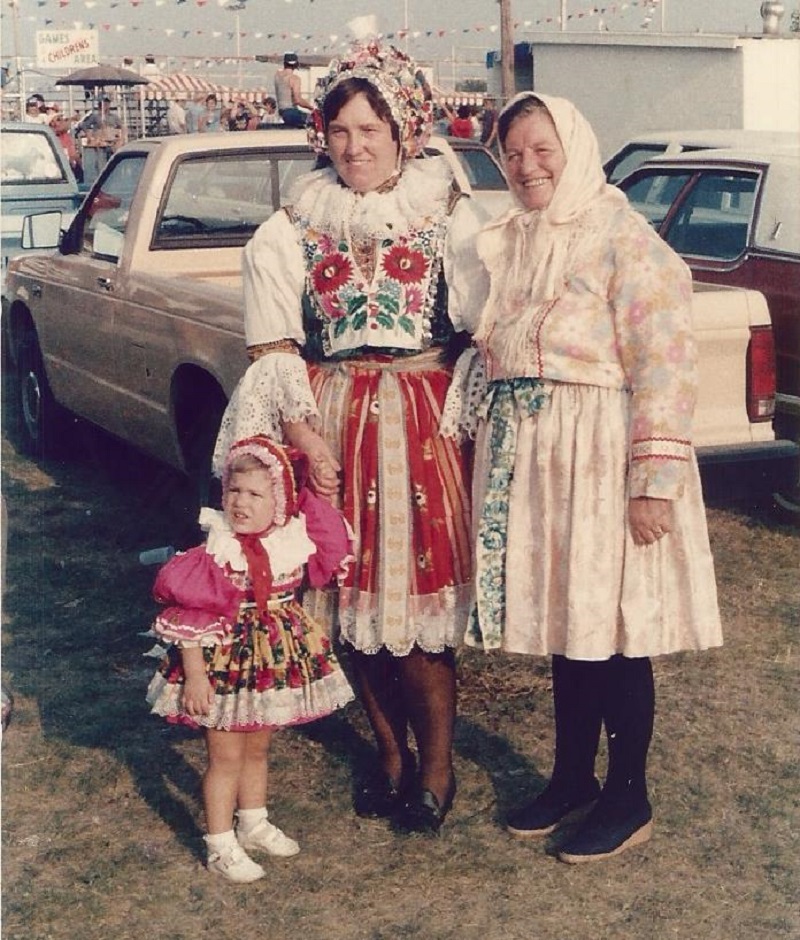
Three generations of Jana’s family wearing their kroje.
As I grew older my grandmother purchased kroj for me to wear, my favorite was the matching hand painted kroj which we wore together. Wearing kroj did not begin with me or my grandmother, mother but with my great-grandmother and beyond.
I have to begin this story with my great-grandmother Marie Šimčíková born Píšťková in the city of Hluk (Město Hluk) located in eastern Moravia. Hluk is located a short distance from the Slovak border, which we can see the hills of Slovakia from our family’s attic window. I have picture of her before she was married of her in her kroj.
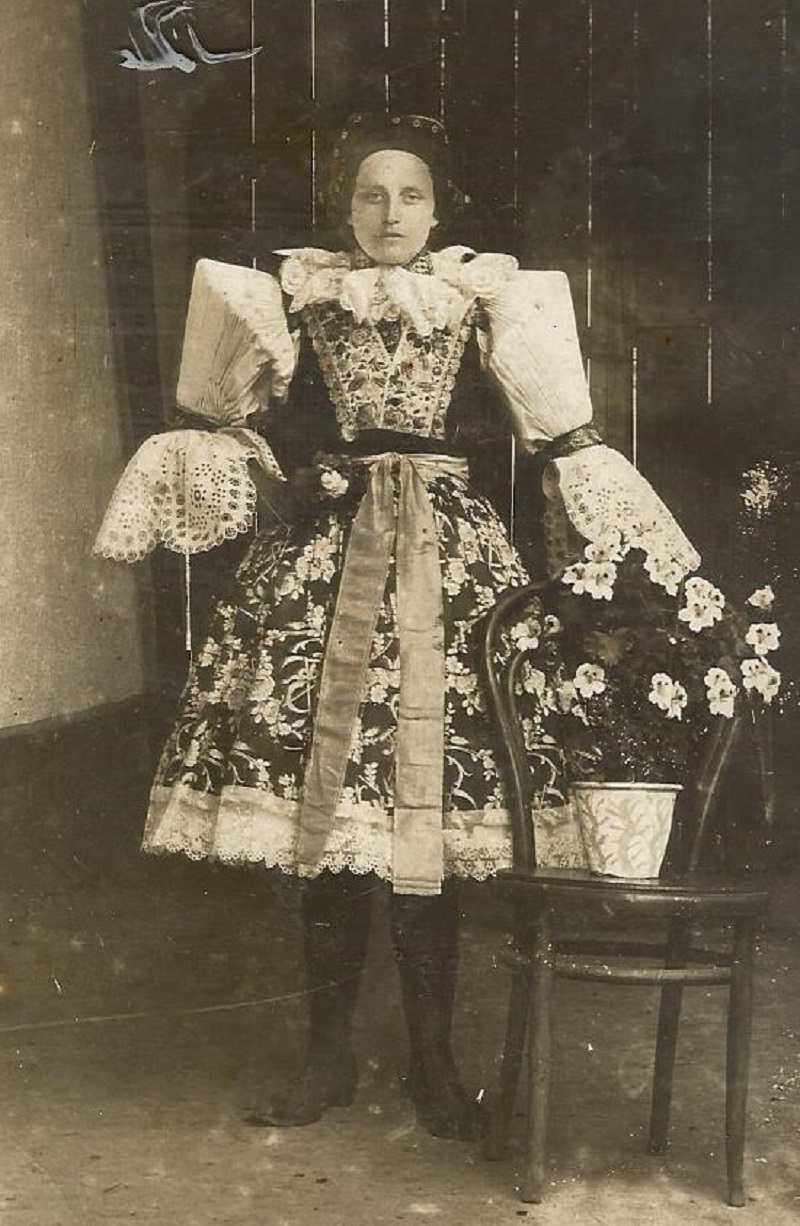
Marie Šimčíková (born Píšťková) wearing her kroj.
I was not able to know her because she had passed away before I was born but I am told she was a kind, caring women who put up with my grandmother’s sometimes naughty antics. Every two years Hluk has a Ride of the King’s festival which several villages in the area also put on a kroj spectacular such as Vlčnov, Kunovice and Hluk.
My grandmother also wore kroj growing up in Hluk and even wore one specifically as part of a wedding.
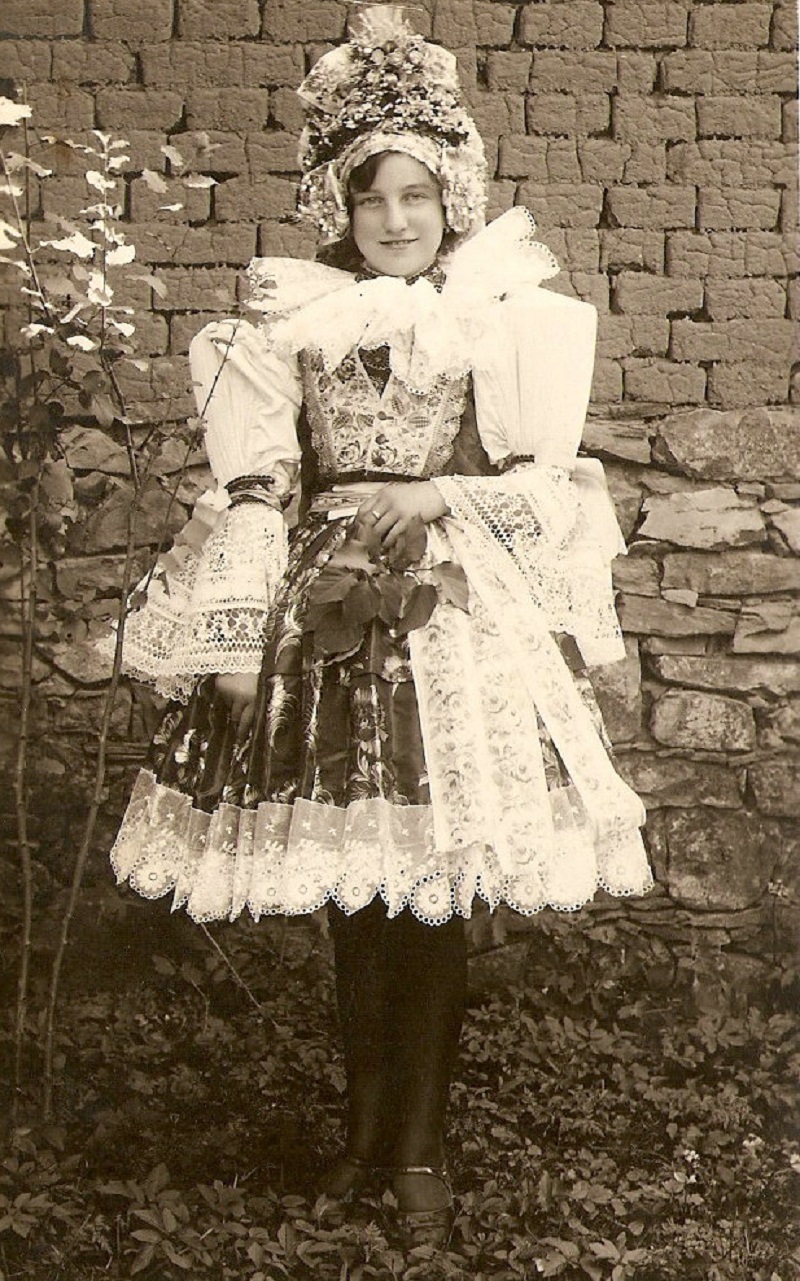 (Gallery of images of Hlucký kroje from their city website.)
(Gallery of images of Hlucký kroje from their city website.)
She traveled to Prague in 1938 to participate in the last Sokol Slet (a slet is a gathering) before the Nazi invasion and communism. During the years of communism my grandmother wore her kroj as well and participated in the Ride of Kings festival. My grandmother raised two sons by herself with the help of her parents. My grandfather had to leave Slovakia in 1948 because of the communist coup and he escaped to Canada through Austria. In 1964, my grandmother made the journey to America and was reunited with her husband, and then my father came in 1968 when he was 23 years old. My great grandmother came to California in the 1970’s and passed away before my grandparents moved to Texas. My great-grandmother was foretold by a gypsy that later in life she will be making a journey to an unknown land which she did when she was in her seventies and went to America.
My mother, who is from Northern Bohemia and did not grow up wearing a kroj, began wearing a kroj in Texas when she married my father. She left in 1980 to marry my father, and my brother and I were both born in Texas, both of us speaking with Moravian dialect and I wearing my kroje.
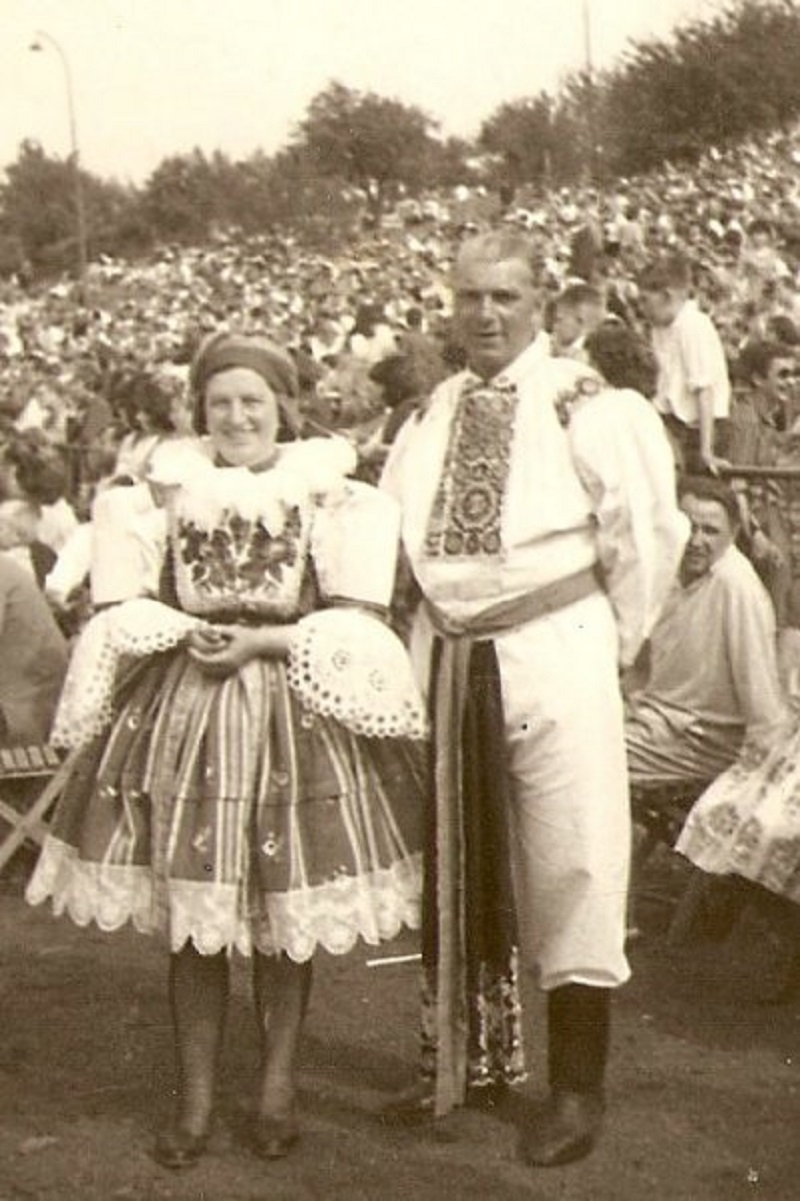 I have always worn kroj from Hluk and will continue to do so. My grandmother left communist Czechoslovakia with permission of the government so after 1968 she made several trips to her homeland. That is how I came to have my kroj when I was born in 1982 and the one I am pictured wearing below.
I have always worn kroj from Hluk and will continue to do so. My grandmother left communist Czechoslovakia with permission of the government so after 1968 she made several trips to her homeland. That is how I came to have my kroj when I was born in 1982 and the one I am pictured wearing below.
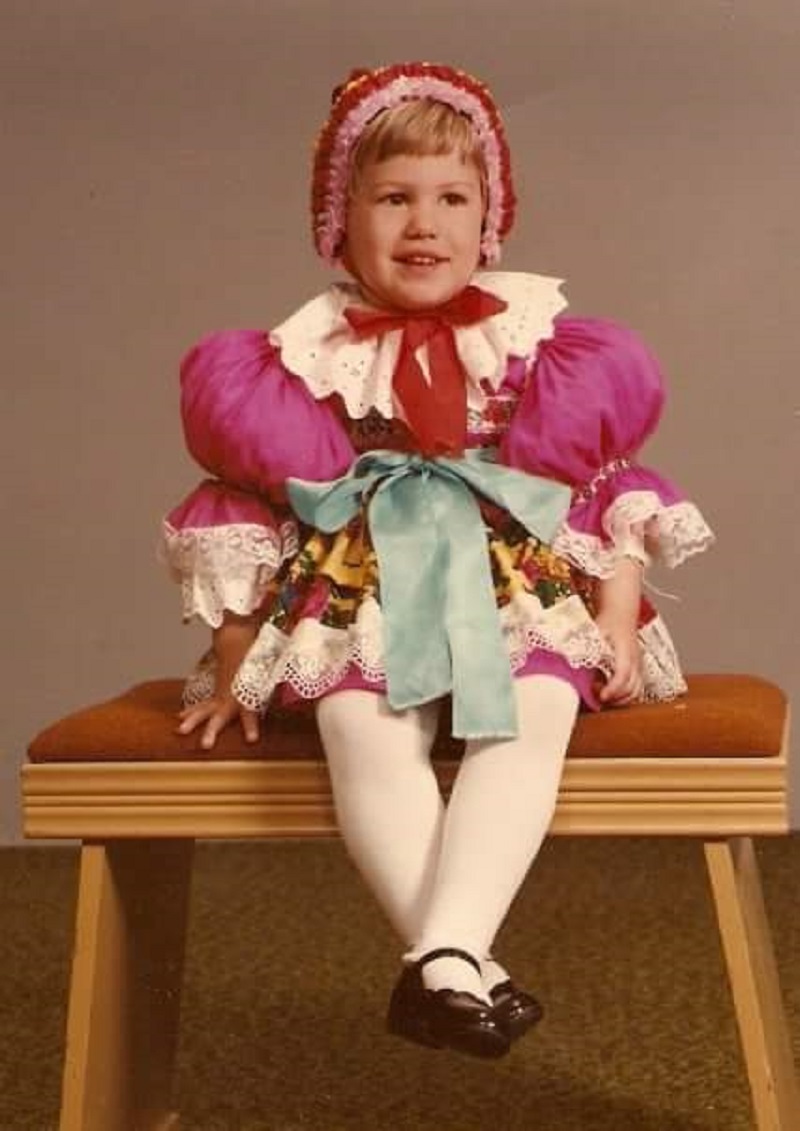
A young Jana Riley, wearing her kroj.
We do not have many pictures of the family after and before World War One because my great aunt cut up the family photo album when she was small, so the ones we do have are precious.
During my great-grandmother’s time, a kroj was worn for their wedding day. A young lady would work on her kroj during the winter months, embroidering flowers and geometric designs on vests, blouses and skirts. Everything was handmade and passed down to the next generation. A mother would teach her daughter to embroider and young girls would start making their wedding dress in their teens or younger.
My grandmother was taught embroidery in school in the 1930s in Czechoslovakia (rather, Moravia). Other occasions when the kroj would be worn would be on feast days, festivals, first confirmations, funerals, mass and any other special event. Their everyday clothing for the fieldwork was different from what they wore to church. Up until World War Two and the 1950s in Czechoslovakia, Moravia and Slovakia, kroje were worn as wedding dresses in the rural areas.
The traditional kroj from the village of Hluk is very beautiful and takes about 30-40 minutes to put on, which you cannot do by yourself. My grandmother had me dressed in 15-20 minutes, depending on what version I would wear. I could wear a simpler kroj or a very elaborate bridal kroj with headpiece and ruffled sleeves.
The ladies have it tough because each layer of skirts has to be tightened and they have to make sure the hems are even and their petticoats are not showing which is one of my pet peeves. My father has a saying in Czech “Parado trp”, which loosely translates to if you wanted to look good you have to suffer, ladies.
Smaller villages often have a unique kroj, and these are to be found more in the Moravian region then the Bohemian regions.
The Anatomy of a Kroj
First off, a Kroj is singular, and kroje is the plural form of kroj in Czech.
Ladies – Head to Toe
Headpiece of headdress is called a Čepení
It can be a, wreath of flowers, cap, or a headpiece with ribbon or a bare head. A wreath of flowers can represent a single young lady, a scarf can represent a single lady or a married woman depending on the kroj and age of the lady.
Collar is called an Obojek
A collar can be heavily embroidered, pleated, eye lace, or just a collar along with a blouse,
Blouse is called a Blůza or Halenka
A simple plain one with no embroidery almost always has some sort of puffy sleeves or scarf around the shoulders.
Sleeves are called Rukávce
They can vary in sizes and simplicity. Some are heavily starched and lacy puffed sleeves or are made out of cotton or linen. The sleeves are sometimes the hardest to take care of and cleaning and storing.
Petticoat is called a Sukňe
Depending how thin you are or how your kroj is supposed to look like, you might be wearing as many as three or more heavily starched petticoats. You have to get that bell shape look from the front created by the petticoats.
Back Skirt is called a Šorec
There is sometimes a skirt that ties to the front and a separate one that ties to the back. It can be made entirely made out of one piece of fabric with just an apron in the front. (Ex Kyjovský kroj.) Usually a sorec will come in white for a bride and black for a married or single lady. Sometimes the sorec will look like accordion style pleats with embroidery or a ribbon sewn on top and knee length. Or ankle length white linen in the Hana region.
Front Skirt or Apron is called a Fěrtůšek
This is the first piece of the kroj people notice or maybe the sleeves are a close second. The front apron/skirt and back skirt must be the same length. They can be short, only to your knees or long, to your ankles. Ribbons are tied around the waist. They can be embroidered, woven, or painted. Ribbons are also used in the hair, headpieces, and above your elbow to accentuate the sleeves.
Shoes
Shoes vary by region. Some have special boots with metal on their heels with embroidered leather and are knee length. Some look like moccasins, ankle boots, dress shoes with no panty hose or stockings or with tights in black, white, red.
Men
Basically the guys have it made because they just have pants, a shirt, belt, boots and a hat. They can have either wool pants or linen. Their sleeves have eye lace, embroidery, and the woolen pants are embroidered. Sometimes they have rooster feathers in their hats to symbolize who is the bridegroom or how many girlfriends he is seeing if he is single.
Winter and summer kroj
There are variations for the winter and warmer months. A kroj can be worn both in the summer and winter months. Men and women may wear a woolen coat with embroidery or scarves. The kroj for the warmer months are more elaborate while during the colder months the colors are more subdued and much simpler.
I have experience in helping my grandmother purchase kroj for others and help individuals find a kroj from a specific village and region. I have tried to compile a list of frequently asked questions and things to think about if you would like to purchase a kroj.
You will have to make most of your decisions about buying a kroj before you leave the United States unless you purchase it online from the kroj maker themselves.
If you go to the Czech Republic to purchase a kroj, the most important step is taking the time to do research before you leave, which saves you time and frustration, especially mainly finding out the location of shops and the expert help. Once you are in the country you might not have time to find out everything and get everything you need unless you plan to stay two or more months when the typical visit lasts 10-14 days.
Here is my advice compiled into what I call Kroj 101…
Kroj 101
You will have to make many decisions when selecting a kroj.
Decision One – Where Are Your Ancestors From?
You have to choose whether or not you want a kroj from the village of your ancestors or if you just want any kroj. With the latter option you have many choices but more choices for Moravian and Slovak kroj than for a Czech or Bohemian one. Not every village has a kroj especially if your ancestors came from Bohemia.
If your specific village of origin does not have a kroj, you might have to find a village next to yours or have to get a regional kroj. A regional kroj will have the characteristics of the region but it might not be specific to your village.
Special note: The vast majority of Texas Czechs are descended from Moravians, specifically Valachs. This region Valasko, does have a kroj but depending on what village your modrotisk (blue/white stamped fabric) will be unique to that village. There are subtle differences in the color of the vest, ribbons and the blue and white fabric for the skirt.
Decision Two: How Much Are You Willing To Spend?
You will need to consider your budget. You must have a budget in mind because getting a brand new kroj can cost you between $300-$500 or more per person depending on what kroj you are getting. They can take 3-6 months to make and you may have to take specific measurements. Each kroj are custom made, especially the boots. The boots from my dad’s village cost 3,000 to 4,000 crowns ($235) using $1 = 17 crowns conversion.
Decision Three: Do You Want a Brand New Kroj or Do You Want an Older Kroj?
There are shops in Moravia that sell fabric and make kroje. There is also a factory in Uherský Brod or Kunovice which will make the brocade fabric and other parts of the kroj.
In each village there is sort of a “keeper of the kroj traditions”, this is typically an older lady who makes, cleans or lets you borrow a kroj. There may also be a tailor or shoemaker gentleman who makes the traditional boots and kroj for the men.
As mentioned before American tourists may think that Czech people in Czech Republic wear kroj everyday but they do not. They wear them for special occasions such as first communion like my dad’s village, feast days, festivals, and so on. If they are in a folk dance group, they will wear them. The traditions in Moravia and Slovakia have been kept so they are more likely to have kroje and wear them in those regions.
Older kroje are also available and people are willing to sell them because the younger generations think it is old fashioned and show little interest. The older ladies often have a trunk full of kroj pieces. But several challenges exist with this option. The first is that you have to know who to talk to and then be able to find them and see if they want to sell. You will have no guarantees of the condition and these old kroje may be stained, eaten by moths, or half completed pieces. Sometimes it is just plain luck that you find a complete kroj. The second challenge to buying an older kroj is that you may find pieces of the kroj but not the complete set.
The only rule in Kroj 101 is that you cannot mix and match pieces from different villages or you look like a scarecrow. Again, do not mix and match. And people will know you are mixing and matching. I do.
Are you willing to take a chance while you are in the Czech Republic that you will find a kroj that will fit you and is in good condition and is not expensive? It’s risky business.
The only positive about buying an older kroj is that it might be cheaper, unless you have an older lady who wants to make a little bit more from ‘the Americans’. You might have to bargain. The negative is everything I mentioned above as well as the possibility that the kroj might only be a museum piece. An old Czech, Moravian or Slovak kroj cannot stand up to the Texas heat, and over time the sweat will completely ruin the fabric.
Decision Four: Hire a Seamstress or Kroj Maker or Buy the Fabric and Make It Yourself?
There are people who have made their own kroje, but it does not always look right. If you know what you are doing and are a very good seamstress with a lot of patience you can make a good quality authentic kroj copy.
Sharon Mena, originally from West, Texas, made her daughter a Kyjovsky kroj when Sara was the Miss Texas Czech Slovak Queen and then was crowned the national Miss Czech-Slovak US. A Kyjovsky kroj is the most elaborate and beautiful out of all the kroje, but it is very time consuming to make by hand. In fact, it took Sharon 2,000 hours and 1 1/2 years to make Sarah’s kroj. No, that is not a typo. Two thousand hours. You can read all about it at Sharon’s blog.
Sharon also made a kroj from the Hana region for Sarah, and she posts regular updates. I admire her for her talent, and she in turn is teaching and inspiring others when they want to make a kroj of their own.
By doing it yourself, you will not have an authentic kroj directly from the Czech Republic, but when using materials from the Czech Republic, you can make a kroj that is the same as in the Czech Republic. There are also Texas-made Czech kroje which are totally wearable and washable for the Texas heat. Visit Czech Costumes to learn more.
Another alternative is searching for kroj or kroje on Ebay to buy your pieces but you might not get the exact piece you need from a specific village. I have bought them online before and have been satisfied so far. Also, keep in mind it is an auction – so if you are not near a computer you might get outbid. You also have to decide how much you are willing to pay for something you cannot see in person.
There are people who do not want their kroj so they sell them. I guess you can also ask around the Czech community or put a classified ad in the paper.
Decision Five: Are You Willing to Take the Time and Effort to Care for an Authentic Kroj and Learn How to Wear It Properly?
You cannot simply take your kroj to the dry cleaner – although some people have – but I do not know what can and cannot be dry cleaned and you will not want to risk leaving it in inexperienced hands. Women and Ladies’ kroj have a lot of beading, lace, sequins, and cording that will get damaged if put in the washing machine. The fabric also easily bleeds, so you cannot just put it in the washing machine. Once you get ketchup or wine on it, the kroj piece is most likely ruined forever.
Storing a kroj when not wearing it is also important because some pieces cannot be hung in a closet. Depending on what they are, the fabric might stretch out. It is best to keep your kroj in a cool, dark, and dry place – whether in a suitcase or plastic storage container – to protect it from the humidity, moths and even sunlight.
Wearing your kroj correctly is also important. When you are out in public you are representing a culture, a way of life and something very special. You must think of yourself as an Ambassador to the Czech Republic when you wear your kroj. This means that your underskirts/petticoats and your apron and back skirt must be even. Your ribbons must be tied correctly and not in some haphazard way. Your collar must be straight and not twisted and it should fit properly to your figure. The last thing you want is to be busting out of your vest because it’s too small or to wear a kroj with discolored, faded or stained fabric. Finally, the biggest no-no in caring for your kroj is to wear it without the proper starching and ironing. Remember, you are an Ambassador wearing a national folk costume representing your heritage. You do not want to be caught not representing the kroj properly.
I hope my writing will help people to understand why I personally wear my kroj and the pride I wear it with. I wear it because it keeps me close to my grandmother who has passed away, and my great-grandmother whose vest I still have and cherish.
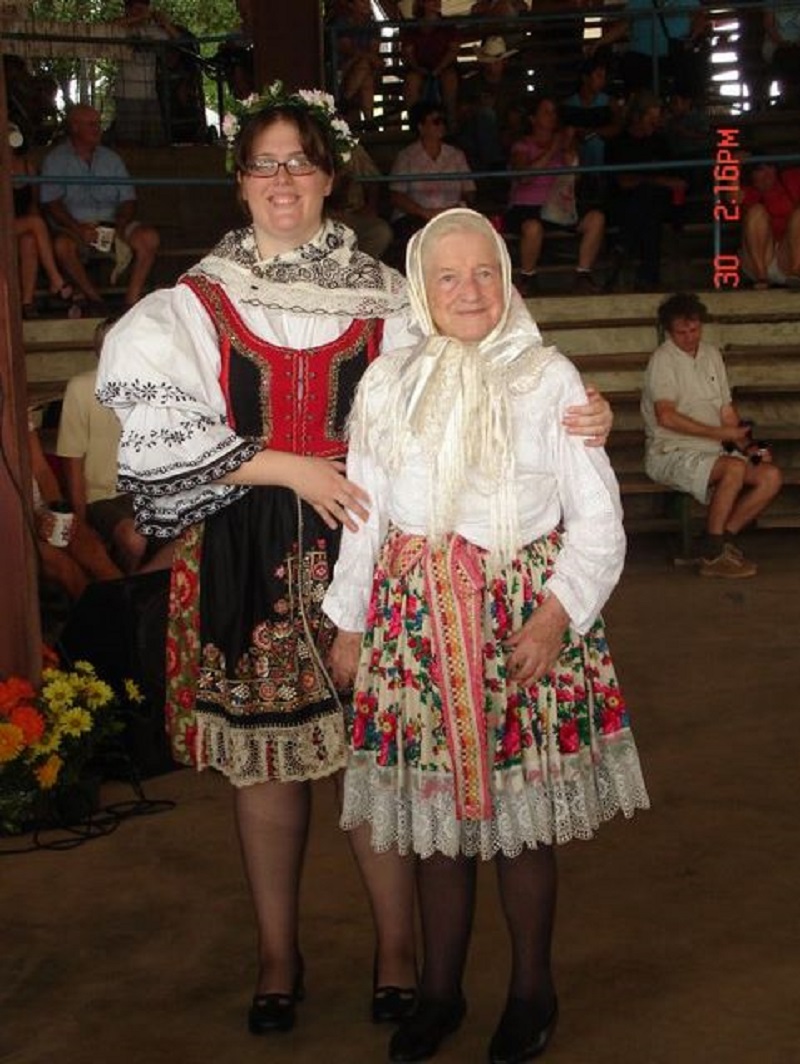
Jana and Ludmilla, proudly wearing their kroje.
I proudly wear my kroj at occasions and I will continue to do so because it connects me to them and to my ancestral country. I love talking to people and answering their questions such as “are you hot?”, “is that headpiece heavy to wear?”, etc.
I am continuing a tradition and wearing my kroj and that makes me very happy and I am happy that I could share this with you today
– -♥ – –
 Jana Riley and her husband are founders and moderators of the Texas Czech Events group on Facebook.
Jana Riley and her husband are founders and moderators of the Texas Czech Events group on Facebook.
You can also follow her at her For The Love of Kroj Parade at Westfest Page, also on Facebook.
* * * * *
Thank you in advance for your support…
You could spend hours, days, weeks, and months finding some of this information. On this website, we curate the best of what we find for you and place it easily and conveniently into one place. Please take a moment today to recognize our efforts and make a donation towards the operational costs of this site – your support keeps the site alive and keeps us searching for the best of our heritage to bring to you.
Remember, we rely solely on your donations to keep the project going.
We appreciate you more than you know!
If you have not already subscribed to get TresBohemes.com delivered to your inbox, please use the form below now so you never miss another post.





